My French Lady – Mirage IIIO A3-10, No 3 Squadron, Royal Australian Air Force, 1/32 Italeri
Greetings, gentlemen - and ladies if any present. I'm hoping that, just this once, you'll grant me a fair chunk of bandwidth. You see, I hit the big 80 this year, and next year it will be 40 years since I assumed command of No 3 Squadron, Royal Australian Air Force (RAAF), at Air Base Butterworth, Malaysia, having previously served as a Flight Commander, and later Operations Officer, at the same unit from 1970 to 1972. The unit operated the Mirage IIIO during both those tours, the model representing my flagship (A3-10) when I was Commanding Officer on that second tour.
I was very pleased to be appointed to command No 3 Squadron, the more so because the unit has a long history. In fact, it is actually older than the RAAF, having been formed at Point Cook, Victoria, in September 1916 as a squadron in the Australian Flying Corps (AFC), part of the Australian Army. (The RAAF came into being in 1921.) After formation, the unit sailed to England for training, before becoming the first AFC squadron to be deployed to France. It was equipped with the R.E.8s, and was initially based at Savy. During World War II, the squadron served the entire conflict in the Mediterranean theatre as part of the Allied Desert Air Force (later the First Tactical Air Force), supporting the 8th Army. After taking part in the Allied invasions of Sicily and Italy, it was re-equipped with P-51K Mustangs and continued to operate in Italy and Yugoslavia until the end of the European war, finishing up as the highest-scoring RAAF squadron, with 217.5 enemy aircraft destroyed.
Anyway, in addition to that 40th anniversary I previously mentioned, a month or so ago the first two of No 3 Squadron's F-35s arrived at the sacred turf of the Australian fighter pilot (RAAF Base Williamtown, NSW), the unit's F/A-18s having been transferred to another squadron prior to the initiation of re-equipment with the new-generation fighter. So there it was: between the time I stepped out of a fighter aircraft for the last time and the arrival of the F-35, a whole fighter generation - the F/A-18, which replaced the Mirage IIIO - had come and gone in my old squadron. And, man, do you think that makes me feel old!
http://members.iinet.net.au/[email protected]/miragea.jpg
The French Lady. Yes, that's how we RAAF Mirage jockeys invariably referred to the Mirage IIIO, in my view quite the most beautiful jet-powered fighter ever designed - and I will brook no argument about that. To us she seemed to represent the embodiment, in metal, of French elegance, sophistication and vivacity, and I never met a fellow fighter pilot who did not have a very soft spot for that petite, wasp-waisted, delta-winged mademoiselle. Yes, of course the most important feature of any fighter is its capability to smite the enemy a deadly blow, but The French Lady's philosophy seemed to be that she could see absolutely no reason why she should not look absolutely stunning while doing so.
For all that, it must be said that the introduction of the Mirage IIIO into RAAF service did not go at all smoothly. Indeed, when you read the accounts of those early days you could be excused for thinking that, in 1960, having eliminated the other contender (the F-104), the RAAF took on board a version of the Mirage IIIE that was simply not ready for prime time. Compare that with our experience many years later with the replacement (the F/A-18), which was ready to rock and roll straight out of the box.
The first two IIIOs were built in France and the remaining fleet of a further 98 IIIOs and 16 IIIDs were built under license in Australia, as was the Atar 9C engine. (The IIID was the two-seat trainer variant used in the early stages of conversion training. No radar, less fuel.) As soon as production test flying began, problems began to emerge. These early problems included, amongst many others, engine vibration issues, air conditioning system turbine failures, engine starter issues, engine compressor surges when manoeuvring in the top left (low speed, high altitude) corner of the flight envelope, some engine failures and, on one occasion, a canopy disintegration. That latter occurred to an old Avon Sabre squadron-mate of mine named "Stu" Fisher. He was doing a production test flight in a IIID with a flight test engineer in the rear seat. The schedule called for a Mach 2 run at the tropopause and, when they were getting close to Mach 2, the canopy shattered. The explosive decompression and wind blast shook Stu and his passenger up quite a bit, but they both survived. The incident eventually resulted in strengthened canopies being supplied from France.
If you are interested in this sort of thing, incidentally, I would recommend the excellent article by test pilot Air Commodore Geoff Talbot titled The Edge of the Envelope at page 49 of this book:
https://fsb.raafansw.org.au/docPDF/the_raaf_mirage_story_opt_1.pdf
As described in that article, the RAAF's Aircraft Research and Development Unit (ARDU), which I had the pleasure of commanding from '88 to '89, was heavily involved in rectifying some of the early deficiencies in the Mirage IIIO, and with acquiring data on the bird's performance in the tropical atmosphere in the northern reaches of Australia. For that latter, several deployments were conducted to Darwin in the Northern Territory during the "wet" season, when surface temperatures are very high, humidity is around 100% and, as is usual in tropical regions, temperatures at altitude are far lower than they are in temperate regions. It was during the first deployments that it became abundantly clear that we had bought a European aircraft that just wasn't going to hack it in the tropics. I quote from Geoff Talbot's article: "In-flight cockpit conditioning problems occurred in three areas; the pilot was too hot in high speed, low level operations; because of cold soak at high altitude, the pilot's instruments fogged up (internally) during descents; and, most critically, the windscreens and canopy, for the same reasons, clouded over with condensation during descent to the extent that all external vision could be lost. Thus, in the worst case - and it happened in service - the pilot could be faced with total loss of external visual reference when making an approach to land in bad weather conditions and at the same time be denied the use of essential flight reference instruments in the cockpit. The aircraft was usually short of fuel at the same time."
By the time I did my operational conversion to the type, however, all the significant issues had been resolved, and the bird was doing extremely well in service. Indeed the serviceability during my first Mirage tour in No 3 Squadron was absolutely outstanding, and I'm certain it was the envy of our colleagues in No 74 Squadron RAF, based at Tengah in Singapore. No 74 was equipped with Lightning F.6s. I always thought the Lightning was a hugely impressive beast, but its serviceability was just appalling.
So did the RAAF choose the wrong contender back in the late 50s? Absolutely not. The deal-breaker for me was the F-104's lack of an all-hemisphere missile in the air defence role, the semi-active Matra R-530 on the Mirage's centreline pylon being the winning card. There were certain other issues with the F-104 that were somewhat unattractive compared with the French offering. In later years, of course, we became aware of the problems the Luftwaffe and Marineflieger experienced with the F-104G. It was a real widow-maker - 292 lost from the total fleet of 916, with 115 fatalities. Rejecting the F-104 also meant that we avoided being tainted by the Lockheed scandal - the utterly corrupt methodologies adopted by that company back in those days in its efforts to sell its aircraft internationally.
To be fair, however, our loss rate with the Mirage was also fairly typical of that technological era: 42 lost out of the original fleet of 116, with 16 fatalities. Of those losses, 18 were the result of engine failure, and 6 were the result of undercarriage failure alone. Compare that with the aircraft's replacement. The F/A-18 entered service in 1984. Four were lost in the early years, but the RAAF has not lost a single F/A-18 since 1992. To a fighter jock of my era, that's just extraordinary. I can only attribute it to more advanced and reliable technology, two engines instead of one, and of course the competence and professionalism of all concerned.
During my time as Commanding Officer of No 3 Squadron, herding a bunch of over-confident hot-rock fighter jocks still young enough to be quite unacquainted with Mr Gillette's excellent invention, the unit was honoured by a visit from a representative of the French magazine AIRFAN. This occurred on 4 March 1981, and I have chosen to represent my model of A3-10 as she appeared on that particular day. Thus you will see not the slightest suggestion of weathering on the model because A3-10, together with three other birds, were specially prettied-up by the “troops” (ground crews) for the aerial photo-shoot we had agreed to do for AIRFAN.
http://members.iinet.net.au/[email protected]/mirageb.jpg
http://members.iinet.net.au/[email protected]//miragec.jpg
With regard to the model, which is from the Italeri 1/32 Mirage IIIE kit, I should mention that the cockpit is a resin replacement. It more accurately represents the IIIO's “office”, and was given to me by expert modeller and good friend Eric Galliers, who flies for Qantas. The kit seat was also replaced by a resin version more closely representative of the Martin Baker version I sat upon. Some decals were supplied by another good friend, Andrew Doppel, who built a superb example of my flagship from the Italeri kit, and thus inspired me to have a go myself.
The strange thing about the Mirage IIIO was that there were quite a few reasons why pilots should have seriously disliked it: the cockpit was tiny; fuel system management was far more complicated and involved than it was in the Avon Sabre, whose system operated as if it was just one big fuel tank with a single guage; take-off speeds were very high and the threshold speed on approach was a blistering 190 knots; the nose attitude on landing was very high, causing a somewhat restricted view of the runway; there being no bubble canopy, the view to the rear was severely restricted, a real liability in fighter-versus-fighter manoeuvring combat; the fuel capacity without the larger external tanks was quite limited, and you never really had anything remotely close to the reserves that our F-IIIC, C-130, and P3C crews (for example) rightly insisted on; you had to be very careful, when manoeuvring tightly at high altitude, not to induce a compressor stall, the intakes being a tad sensitive to a misaligned airflow; it had very limited loadout capabilities in the ground attack role; problems with the doppler feed to the navigation system were never really resolved; after an overnight downpour in the tropics, you could almost guarantee that there would be a couple of (possibly) false engine and/or afterburner fire warning lights next day; the low aspect-ratio delta-wing may have had certain aerodynamic and structural advantages, but certainly not at the low speed end of the flight envelope, or when you were engaged in maximum performance manoeuvring, because large increases in the angle of attack of the wing meant incurring massive amounts of induced drag; when the engine flamed out, the bird lost all faith in itself as a flying machine, the minimum drag (and hence best “gliding”) speed being 300 knots, and she dropped like a stone with an absolutely eye-watering rate of descent. There are other things I could mention.
So, in light of that, how was it that this aircraft, despite its little quirks and annoyances, managed to engender in the pilots who flew her a genuine and enduring (dare I say it) affection? I can only put it this way: she'd spend all your money, she'd insist that you only take her to the most expensive restaurants, she'd keep you waiting for an hour while she got ready, she'd flirt coquettishly with all your mates, she'd burn your dinner and then insist that you probably weren't hungry anyway, and she'd put dents in your brand new Citroën DS and think nothing of it. But you'd forgive her for anything, and continue to enjoy her delightful company, because she was, after all, the incomparable and inimitable French Lady.
http://members.iinet.net.au/[email protected]//miraged.jpg
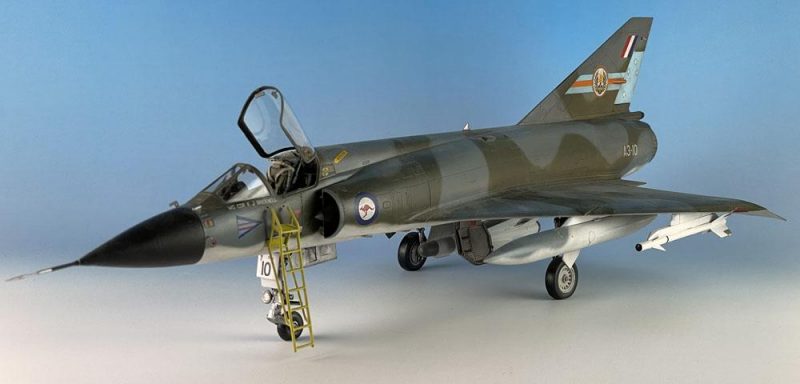
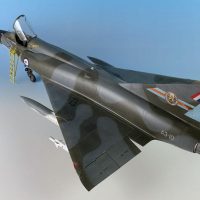
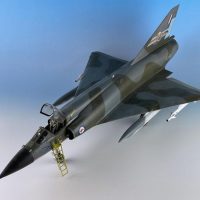
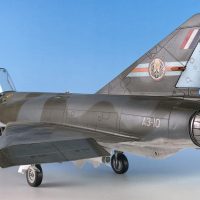
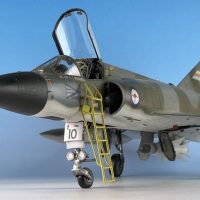
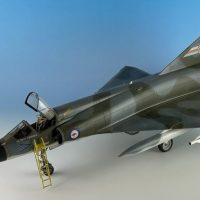
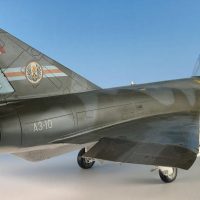
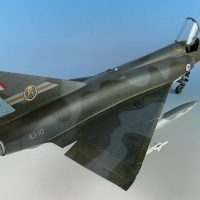
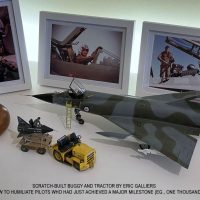
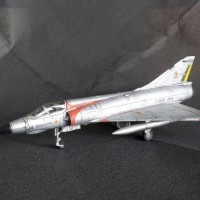
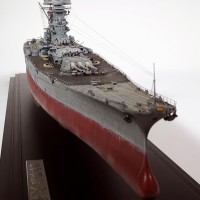


A most interesting read, sir...thanks for sharing it. And an equally nice rendition of the "Lady" as well.
Wow. Compelling story and a beautiful and meaningful model.
A fascinating article, K.J. You've given her character & a personality.
She's a pretty nice lookin' lass as well & something to be proud of.
You've done a great job; in both respects.
Beautiful model of a gorgeous aircraft, Sir! I really appreciate the "inside scoop" so to speak. I like all the delta-winged aircraft ... they were MY first favorite jets. To me they always looked like they're racing along at Mach 5, even while sitting still on the tarmac!
Bravo!
What a privilege to read your memories while commanding and flying the Mirage in the RAAF, and then see a gorgeous model of your own mount. Outstanding model in my opinion, beautifully painted and with all details that make this a great display. Top work and thank you for sharing with us
Excellent article K.J. Enjoyed the insider read and the view of a very pretty French Lady. Like it a lot.
The article reads like it was written by a fighter pilot...adjectives used fast,cars,ladies,and women seam to be the regular lexicon of most pilots. Great read about the type and the aircraft's strengths and weaknesses. The modeling is superb as are the photos. It must have been done with love and affection given the perfection of the piece.
Considering the aircraft's vices... you read what the IDF did with the type and when used with capable hands and minds it was game changer in the middle east.
Two thumbs up.
Great post, super model. A labor of love all the way 'round. Love it.
Loved your post! I'm also a fan of the Dassault Delta-Winged Demigods, and it was interesting to see how a pilot felt about the aircraft. Beautiful model as well.
Beautifully written post, KJ. In terms of the Mirage, she is gorgeously painted;
rich, lovely modulation, and there is a real depth to the surfaces that is very satisfying.
‘Liked’
Fantastic model and post, I love the build as well, just fantastic...
La di da. A real classy French sheila!
I love the Mirage III and your model is really nicely done. Your article is a pleasure to read, it seems you have had nice times with this plane !
Wonderful article - So good to have this 1st hand history with a great model for illustration